Baroque movement was inspired by Michelangelo's mannerism's inventive and expressive reformulation of rigid renaissance rule. Baroque as you know is an over decorative movement, it basically add what’s not needed, composing of a lot of ornaments. Its different from early renaissance in that it over exaggerates the elements, the movement was inspired by Michelangelo. Bernini and Borromini adopt Michelangelo's idea and push it further. I think it is like post modernism and modernism in a way.
Modernism to me is like an early renaissance, using elements such as columns, dome, and pendant. On the other hand, post modernism is somewhat the opposite, over exaggerate components. Michelangelo’s buildings use architecture elements that both support and not support buildings; originally each column is specifically calculated and measured to support the building. Michelangelo plays with the idea that not all elements are needed, columns in his buildings sometimes doesn't touch the ground. Later after Michelangelo died, Borromini and Bernini used this idea of misplacing decorative elements.
Borromini, unlike Bernini is a commoner- modest, receives no rich commission and do not have the luxury as Bernini has. San Carloalle Quarttro Fortane, 1634
Small chapel where Borromini achieved with only form, light and geometry
He use simple, common, cheap material to make complex geometry. Although the materials are cheap, he was able to create more expressive architecture than Bernini's design. His architecture is very modern AND (post modern) in a way that it is full of complexity and contradiction in it self. He used simple geometry and turned them into something really complicated…simply by arrangement.




